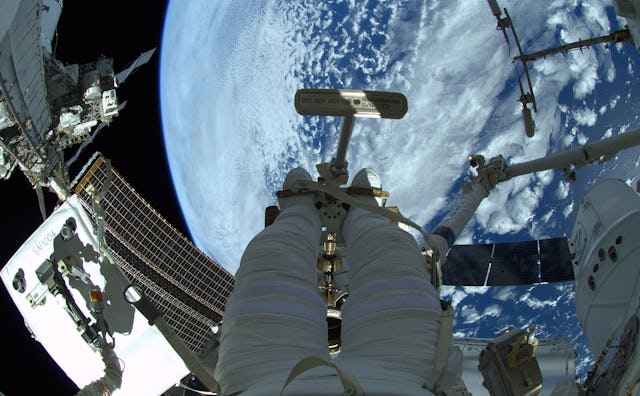Burning Water, Floating Fire, and Other Mind-Blowing Science From the International Space Station

In October, the rocket Antares exploded just seconds after its launch from the Wallops Flight Facility in Virginia. Included in its payload were several student-designed experiments, along with materials for the ongoing research on the International Space Station. While those never made it to their destination, there are many other experiments going on at ISS, where we can take advantage of the station’s unique microgravity conditions to find out more about how some very Earthly things work—fire, water, peas, and human moods, for example. Here are some of the coolest experiments from the current crop of research happening in space:
Balls of Fire
When you strike a match, the flame you see is vertical, because on Earth hot air rises and cooler air falls. In microgravity, though, flames form spheres. In the Flame Extinguishment Experiment, or FLEX-2, droplets of different liquid fuels are ignited and observed in a controlled chamber. NASA astronaut Reid Weissman called the flickering circles he observed wandering their test chamber almost as if they were alive “jellyfish of fire.” Scientists are studying these spheres of burning fuel droplets in order to learn more about soot formation and the speed at which different fuels burn. This knowledge could help produce more efficient liquid fuels for use here on Earth.
Vaccinating Mice
Spaceflight has many effects on the human body, one of which is suppression of the immune system. In one experiment, a group of mice on the ISS are given a tetanus vaccine, which activates the body’s immune system in a similar way an infection does. Some mice will also get an immune-boosting serum, to see if it can help overcome the immunosuppressive effects of spaceflight. Monitoring the response of the space mice could yield findings that will help in the development of vaccines and medications.
Actual Fire-Water
ISS scientists are experimenting with a form of water that doesn’t put out fires—it starts them. It’s called “supercritical water,” and it’s created when water is compressed to extreme pressure and heated above 703° Fahrenheit. Above that point, water tranforms into something that is neither solid, liquid, nor gas, but what NASA describes as “a liquid-like gas.” When this supercritical water comes in contact with organic material, it causes a kind of flameless fire. Regular fire creates some unpleasant byproducts (think car exhaust, or campfire site), but combustion by supercritical water creates only pure water and carbon dioxide. The Navy has already started using supercritical water to treat waste on one of its ships—this could be just the beginning.
Veggies in Space
Crewmembers aboard the ISS receive shipments of food from Earth, of course, but in the future, if/when humans take longer trips to asteroids or Mars, astronauts would need to grow their own food. The problem is that the things we know that plants need to thrive—water, sunlight, soil—don’t exist in space. In this experiment, pea shoots are germinated in a lab on Earth and then brought aboard the ISS in special containers that allow them to grow in microgravity. By exposing the pea shoots to different combinations of red and blue LED lights, we can see what produces the best, most rapid growth. Beyond space travel, these humble peas are helping scientists develop best practices for growing vegetables anywhere with minimal light, nutrients, water, and space—on Earth and beyond.
Dear Diary
Perhaps the most fascinating experiment going on aboard the ISS is also the least high-tech: an analysis of astronaut journals to learn about the emotional and psychological effects of the long-term isolation and confinement that come with spaceflight. Being an astronaut might be a dream job, but the day-to-day existence of living and working in space comes with a lot of stress, and (ironically) not a lot of space. Since 2003, different ISS crew members have been writing in personal journals three times a week, recording their experiences and responses and sending entries back to Earth for analysis. Don’t bother scrambling to find them; the journal entries are confidential. If you want personal updates from the space station, you’ll have to get them from Twitter.
This article was originally published on